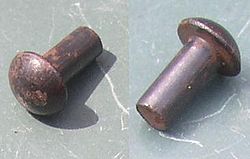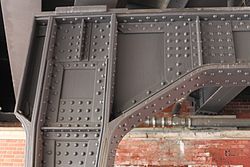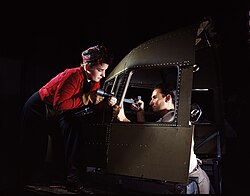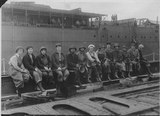Rivet
A rivet is a type of bolt which fastens plates of metal together. Riveting was a main method of building metal ships, bridges and many other complex metal objects. It was developed in the early industrial revolution from earlier ideas. It is no longer the main method of metal fastening, but examples can be seen all over the world.
The key idea is that the slug of metal is red-hot when hammered into place. This results in the slug of metal having a dumbell shape which holds the two metal sheets together. An automatic jackhammer is used to force the metal into position, so giving a bulb on the inside face away from the pounding. The process (for example, of ship building) was very noisy. As the metal cooled, the two end of the rivet were pulled together, making a tight joint.[1]
To be a riveter was skilled work. The men worked in teams of four: two to heat the rivet and pass it to the two fasteners. It was therefore an expensive process even when it was shortened by mechanising the heating process as in the example shown.
Rivets could be tested simply by tapping. A rivet tightly set in its hole gives a clear ring, while a loose rivet produces a different sound.
Riveting developed in many ways, and there are many different kinds of rivets.[2][3] Today riveting has been largely replaced by welding, or by high-strength bolts. However, riveting is still used where light weight and high strength are critical, such as in aircraft.
Examples
Rivet Media
Riveting team working on the cockpit shell of a C-47 transport at the plant of North American Aviation. The woman on the left operates an air hammer, while the man on the right holds a bucking bar.
Women rivet heaters, with their tongs and catching buckets, Puget Sound Navy Yard, May 1919
A typical technical drawing of a universal head solid rivet
An original structural steel rivet from the Golden Gate Bridge (1937). Removed and replaced c. 2000 during work to reinforce the structure to resist seismic loads.









